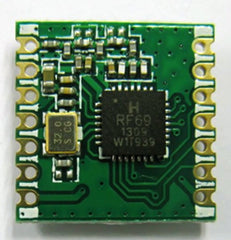RFM69CW Radio
- Vendor: HopeRF
- Type: Components
The more recent RFM69CW radio module by HopeRF is a compact, powerful radio transceiver module for swapping data packets in the 868 MHz ISM band, using standard and enhanced FSK modulation. Great for sub-compact designs; just 4mm of mounted height from using an SMD precision crystal.
Though consuming a similar level of power, the RFM69CW receiver section can decode fainter signals than the classic RFM12B. The transmitter section *maximum* output power is +13dBm, considerably higher than the +5dBm of the RFM12B. The current drain at these (adjustable) higher power settings is correspondingly higher. With the better receiver sensitivity, many applications will not need to use the higher transmit power settings, potentially saving on battery life.
Comparing like-with-like, pairs of modules will generally have greater range and/or better penetration of walls/ceiling than when using pairs of the classic RFM12B.
The physical module is compatible with the PCB footprint on all current JeeNodes and JeeLinks. For details of the fast-evolving level of software support, see this Forum topic.
Control is via a fast SPI bus with reduced MPU loading. The recommended power supply range of 1.8 < Vdd < 3.6 V can squeeze almost the last energy out of depleting batteries without needing a boost converter.
N.B.: An antenna must be connected to the module. A quarter wavelength wire – 82mm for 868 MHz – works fine (not included). Caution: operation for extended periods without an antenna at the higher transmitter power levels risks permanent damage to the output stages.
Ordering Options:
Match your local requirements the SMD 868 MHz module or the SMD 433 MHz module.
The discounted 6Pack options are available for larger requirements.
Typically the 868 MHz ISM band has better penetration of light obstacles such as plaster walls and ceilings plus this band is often less crowded, but you may need a different band for compatibility with other equipment such as weather stations.
For testing, these modules will work in the 'wrong band', but reliably only at bench top range since the antenna matching circuit is then well outside of its intended operating range.
Marking Convention: a yellow spot on the top of the transceiver chip indicates optimised for the 868 MHz ISM band, a green spot for 433 MHz. The bronze spot diagonally opposite marks a successful module test before shipping. This final check helps to avoid the known problem of occasional infant mortality with this class of RF module. You can have confidence that you are building your project with a fully functional module!
For detailed specifications, see HopeRF’s RFM69CW documentation.
The RFM69CW Board provides convenient signal breakout with an option for connecting to 5V power systems.
Modern Device stocks a 915 MHz version of these modules with US$ prices.


